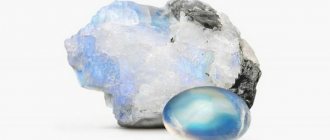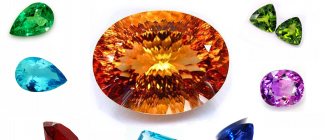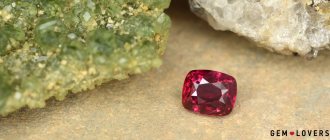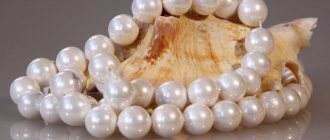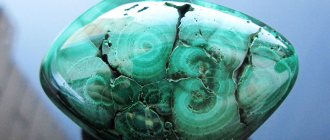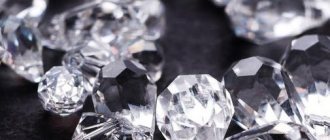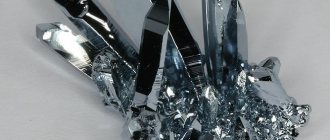Classification of precious stones. Varieties of precious stones by color. How to identify a real stone among the many fakes, imitations and hacks?
Today, jewelry specialists have a much more difficult time than their predecessors. If a few decades ago a genuine gemstone could be easily distinguished from a fake, even visually, then in the world of modern technology and progress it is almost impossible to do this by eye.
In addition to the well-known hacks made of glass, imitators of expensive stones from cheaper minerals, a new product has appeared on the jewelry market today - stone grown in laboratory conditions. Such a creation of human hands visually looks no worse than a mineral created by nature over many decades, but it costs several times less. How to distinguish a genuine natural stone from a fake or artificial stone? What precious minerals even exist?
Black gems: name, description, photo
Black gemstones
There are so many minerals in nature that stand out for their black color. Some of them are so rare that it is almost impossible to find any information about them. In many cases, the name “black” stone can be considered relative, since in fact the mineral has a lighter or non-uniform color. Here are the most common black stones in jewelry:
Gems
Black diamond or carbonado
Black Diamond is the greatest rarity and value in jewelry. However, it is worth noting that it never reaches the level of jewelry, since its cutting and processing is very complex - it can only be done using the same stone. In the annals of jewelry there are only a handful of such stones, the most expensive of which was estimated at 1.7 million dollars. The other two became known as "Black Star of Africa" and "Korloff Noir".
Black Diamond
Black sapphire
True black sapphire does not exist in nature. Almost all black sapphires are the work of scientists. They are obtained by processing blue sapphires. The few black sapphires that are of natural origin can hardly be called black, since their color is closer to the color of the sky at night. The most famous black sapphire is the Black Star of Queensland, worth $100 million.
Black sapphire
Black Pearl
This type of pearl is also difficult to consider truly black, since its darkness is softened by the mother of pearl of the pearl. However, the cost of such a curiosity remains quite high to this day. The rarest specimens of black pearls are collected in Tahiti in the corresponding museum.
Black Pearl
Black opal
This type of opal is considered one of the most expensive and valuable rocks. Most often, this mineral is found in deposits located in the least developed countries of the world, which causes numerous human losses during its extraction.
Black opal
Black spinel
Black spinel is one of the most inexpensive types of black gemstones. Its cheapness is easily explained by the fragility of the stone and the complexity of its processing. Most often, spinel is used in needlework or jewelry in the form of cabochons.
Black spinel
Semiprecious stones
Black quartz or morion is the only representative of semi-precious stones of black color. This mineral is most often used in jewelry today. Externally, it has an opaque or barely transparent surface.
Black quartz or morion
Jewelry and ornamental stones
Black agate
In fact, black agate does not exist in nature. Only dark coal-colored minerals can be found. A rich black color can only be achieved through technological processing of this stone.
Black agate
Other representatives of black jewelry and ornamental stones are: black onyx, obsidian, black jasper or jet, hematite, argillite and hypersthene.
What determines the cost of a stone?
Today, there are five criteria that directly affect the price of a crystal.
Weight
The most obvious point is that the heavier the stone, the larger it is, the more expensive it is. The main unit of measurement is the carat, equal to 0.2 grams. Next, the average market tariff is included in the calculation; here, each mineral has its own “critical” mass. For example, you will not find jewelry with a diamond even half a carat in a regular store, because its cost will be around 500 thousand rubles, but for a ruby this weight or even more is considered the norm.
Color
Jewelry making is a strict compliance with standards; it is not for nothing that everything associated with a noble profession is considered synonymous with precision. This approach also affected the shades of stones, where 14 colors were taken as standards, except for transparent, which is indicated separately:
- Green;
- Red;
- Yellow;
- Black;
- Pink;
- Orange;
- Grey;
- Blue;
- Blue;
- Violet;
- Brown;
- Black;
- White;
- Multicolor.
It should be understood that it is not only the color palette that determines the value. Maximum compliance with the standard is also important. When the shade of cut raw materials is too light or dark, its value decreases, which is good for the buyer, but not for the master jeweler.
Ennoblement
The vast majority of stones, except for transparent ones, end up on store shelves with “pumping” of color, that is, ennobled. This word refers to laboratory procedures, the purpose of which is to bring the blank of future inlay into conformity with its presentation. There are 5 common methods actively used by manufacturers:
- Heating is technologically simple, when pre-cut stones are placed in a special furnace, where they are heated to extreme temperatures. This allows you to even out the shade, make it more saturated or, conversely, mute it.
- Diffusion is an advanced heating method in which each workpiece is pre-coated with ions of a particular metal that serves as a color catalyst. After cooling, the transformation of the shade remains for many years or forever.
- Sputtering is a technology that gave birth to the famous mystic topaz, which has the effect of an iridescent kaleidoscope. It was invented in 1993 in the USA, when a special film of titanium composition was applied to the surface of the mineral.
- Irradiation – radiation allows you to change and “tweak” colors throughout the rainbow spectrum, the main thing is to correctly calculate the dose. The downside is the need to keep processed gems in sealed lead capsules for months.
- Glass filling - more precisely, a special type of crystal is used, which hides physical defects, voids and cracks without damage. According to Russian GOST, up to 50% of the volume is allowed; if more, the stone receives the status of composite.
As you might guess, crystals with minimal changes are valued more than others, but they are found extremely rarely in nature, and in the case of rubies or sapphires they are simply on the verge of fantasy. It is important for the buyer to remember that even an ennobled gem continues to remain precious, and minor interventions do not in any way affect its beauty.
Purity
The most controversial parameter, since many experts call the so-called inclusions in the structure of a mineral perhaps the main criterion of authenticity. Heterogeneity is inherent in any natural element, but jewelry precision requires the strictest classification, so there is a gradation of purity that divides stones as follows:
- Group 1 – the maximum possible shine and transparency, flaws in the structure are visible only under an electron microscope or a strong magnifying glass.
- Group 2 – there are subtle defects that can be seen with a household office magnifying glass.
- Group 3 – inclusions visible to the naked eye, slightly dimming transparency and optical effects.
- Group 4 – fairly large flaws, gloss significantly lower than the standard.
- Group 5 – the crystal structure is damaged, cracks and cavities are present, serious refining is required.
Depending on the manufacturer, a code is indicated on the jewelry tag, most often in the form of a decimal fraction. It should be read with the resulting number so that it is as close to the whole as possible. For example, 3/1 means exceptional quality, pure inlay, but 3/6 results in 0.5 - we have a low-grade insert, close to the fifth group.
Cut shape
It’s relatively simple here - automation of production bases has made life easier for many jewelers, however, intricate shapes still require painstaking manual labor. The following styles are considered popular among buyers, regardless of the category of stone:
- Circle;
- Square;
- Baguette;
- Cabochon;
- Oval;
- Heart;
- Marquis;
- Princess;
- Pear;
- A drop.
Of course, there are a dozen patented cuts - Antwerp rose, happy, magna and many others. Each of them reveals the iridescent brilliance of the gem in its own way, but no one has canceled the rule of labor costs - the more complex the composition, the more expensive the results.
White gemstones: name, description, photo
White gemstones
White or naturally transparent minerals are considered the most expensive and valuable stones in jewelry. White gemstones include:
Diamond or diamond
It is a transparent diamond or an already cut part of it (diamond) that first comes to the mind of any person (especially women) when mentioning white precious stones. Indeed, this mineral is considered one of the most sought after. Its high cost is easily explained by the few deposits of this mineral in the ground. At the same time, only a small fraction of all mined diamonds are suitable for cutting.
Diamond
Transparent spinel
Unlike its black counterpart, white spinel is a fairly expensive stone with a high strength. The impeccable purity and the fact that this mineral contains no impurities makes it even more valuable. White spinel is most often used in luxury jewelry.
White spinel
Colorless topaz
With the naked eye, this mineral can easily be confused with a diamond. However, upon closer inspection, differences can be detected. In jewelry, it is customary to frame colorless topaz in noble white metals - gold, platinum.
White Topaz
Goshenite or colorless beryl
Goshenite is also very similar in appearance to diamond, but its shine can rather be called more chilling and restrained.
Goshenite
Pearl
White pearls have always managed to captivate the fair sex with their warmth and tenderness. Oddly enough, in nature, pearls rarely have a round shape (such representatives are highly valued) - more often they are oblong and uneven. Pearls also have one more feature - their lifespan. If ordinary minerals will delight the eye with their beauty forever, then a pearl can “go out” at any moment. The lifespan of this mineral does not exceed 300 years.
White pearls
Achroite or white tourmaline
This type of rock is very rare, since its deposits are located in only one point on the map. Achroite is quite rare in the form of jewelry. This kind of pleasure can only be ordered from a few jewelry workshops in the world.
White tourmaline or achroite
Semi-precious white stones include white agate, rock crystal and white opal.
Jewelry and ornamental stones can boast of the presence in their list of such white minerals as milky coral, white jasper, moonstone, and white-green jade.
Industrial classification of natural jewelry and ornamental stones VNIIyuvelirprom
With the development of the jewelry and stone-cutting industry in the USSR in 1970-1980. It became necessary to create an industrial classification of jewelry and semi-precious stones suitable for the practical work of this new industry. All-Union Scientific Research Institute of the Jewelry Industry (VNIIyuvelirprom) represented by A.I. Tsyurupa created such a classification. In it, all jewelry and semi-precious stones are divided into three types: jewelry, jewelry-ornamental and ornamental, which, in turn, are divided into subtypes and groups based on transparency, hardness and other properties.
Type I. Jewelry stones Subtype I—1. Transparent stones: group I - 1 - 1. Hardness 10 - diamond; group I—1—2. Hardness 7-9 - corundum, beryl, tourmaline, garnet, chrysoberyl, spinel, quartz single crystals, topaz, euclase, phenacite, zircon, cordierite, andalusite, staurolite; group I—1—3. Hardness less than 7 to 5 - spodumene, chrysolite, kyanite, dioptase, brazilianite, tanzanite, chrome diopside, apatite, benitoite, axinite, scapolite, thomsonite, danburite, ulexite, cassiterite, gambergite, actinolite, green obsidian; group I—1—4. Hardness less than 5 - sphalerite, fluorite, brucite, zincite, scheelite. Subtype I-2. Opaque, sparkling stones: group I—2—1. Homogeneous - hematite-bloodstone, pyrite, cobaltine, psilomelane; group I—2—2. Patterned - hematite - goethite glass head, cryptomelane - hollandite glass head. Subtype I-3. Translucent stones: group I—3—1. Brightly colored stones - carnelian, chrysoprase, chloropal, rose quartz, colored semi-opals, smithsonite, prehnite, zoisite, jadeite; group I—3—2. Stones with patterns or beautiful inclusions - agate, hairstone, mosswood, onyx (sardonyx, carnelian, onyx); group I—3—3. Stones without patterns or colors - chalcedony, semi-opal, cacholong; group I—3—4. Pseudochroic stones with a certain orientation - noble opal, moonstone, iridescent obsidian Subtype I-4. Opaque matte stones with beautiful colors and dense surface texture: group I—4—1. Stones used in products with subsequent processing are turquoise, variscite, coral; group I—4—2. The stone used in its natural form is pearl.
Type II. Jewelry and ornamental stones Subtype II—1. Viscous stones, hardness more than 6: group II—1—1. Jade, jadeite and their hard natural imitations, garnet-chlorite rock, xenolith, fibrolite. Subtype II-2. Stones of medium viscosity, hardness 5-6: group II-2-1. Brightly colored stones - lapis lazuli, rhodonite, amazonite, jasper, unakite (an aggregate of epidote and potassium feldspar); group II—2—2. Patterned stones - petrified wood, graphic pegmatite, patterned flint, jasper, obsidian, heliotrope, perilivte; group II—2—3. Pseudochroic stones - belomorite, falcon and tiger eye, silver (“irisating”) obsidian, aventurine, mother-of-pearl; group II—2—4. Stones used in their natural form: subgroup II—2—4a. Massive stones - buds of chalcedony, smithsonite, jade; subgroup II—2—4b. Crusts and growths - amethyst and quartz brushes, uvarovite crusts, dendrites of manganese minerals, native copper and silver. Subtype II-3. Small and medium hard stones: group II—3—1. Cold processed: malachite, azurite, serpentine, anthracite.
Type III. Precious stones Subtype III—1. Hardness more than 5: group III—1—1. Glassy - obsidians, jaspers, hornfels, microquartzites, ferruginous hornfels; group III—1—2. Heterogeneous rocks and mineral aggregates: subgroup III-1-2a. Ice quartz, taganay quartzite, amazonite granite; subgroup III—1—26. Peridotites, pyroxenites, hedenbergite skarn; subgroup III—1—2c. Listvenite, jaspilite; subgroup III—1—2g. Eclogite, garnet gneiss, tourmaline-containing rocks; subgroup III—1—2d. Granitoids, nepheline syenites, labradorite, porphyry, etc. Subtype III-2. Hardness from 5 to 3: group III—2—1. Translucent - aragonite and calcite onyx, fluorite; group III—2—2. Opaque - marbles, ophiocalcite, anhydrite, serpentine, chlorite-serpentine rock. Subtype III-3. Soft, hardness less than 3: group III—3—1. Translucent - alabaster, selenite, halite; group III—3—2. Opaque - graphite, soapstone, pyrophyllite, brucite, steatite.
In the photo: tanzanites and yellow sapphire are an excellent alternative to more expensive blue sapphires and yellow diamonds
Blue gems: name, description, photo
Blue gemstones
Blue or cornflower blue sapphire
Only an experienced specialist will be able to distinguish these two types of mineral by eye. Blue sapphire is valued somewhat lower than cornflower blue sapphire, but it is still considered a precious stone. As for the cornflower blue sapphire, in ancient times it was used only for inlaying royal outfits and jewelry.
Blue sapphire Cornflower blue sapphire
Topaz
Topaz is most often found in blue, but in nature it also comes in other colors - yellow, green, orange, etc. Topaz is not an overly expensive mineral. Most often it is framed in white precious metals - platinum, white gold. Such metals seem to emphasize its gentle radiance.
Blue Topaz
Aquamarine
Already from the very name of the mineral, its origin and associations associated with it become clear. The marine color of this stone helps jewelers create masterpiece blue jewelry. Aquamarine lovers should pay attention to the fact that this mineral is quite fragile - exposure to chemicals, mechanical damage and heat treatment negatively affect its condition.
Aquamarine
Blue spinel
This color of stone is extremely rare, which determines its rather high price. Framed, it can only be found in exclusive creations by jewelers, which are often kept in private collections and cost tens or even hundreds of thousands of dollars.
Blue spinel
Semi-precious blue stones include: zircon, chalcedony. Turquoise, apatite, bezoar, and amazonite are considered ornamental blue stones.
Semiprecious stones
These minerals are widely used to decorate jewelry, but are not classified as precious gems. Affordable semi-precious stones are popular among jewelers and connoisseurs of precious stones due to their wide selection of shades and textures.
Pomegranate
Semi-precious mineral of rich red color. Yellow, green and even black specimens are also found in nature.
Color range : red, yellow, green, brown, black pink, orange, colorless.
Properties : promotes accelerated regeneration and normalizes blood pressure.
Zodiac compatibility : Aries, Aquarius, Gemini.
Topaz
It is an aluminum silicate containing fluorine. Topaz is a beautiful multi-colored semi-precious mineral.
Color range: depends on the characteristics of the crystal lattice. Can be white, blue, red and yellow.
Properties : helps with ulcers, colitis, anorexia and bulimia.
Zodiac compatibility : Scorpio and Sagittarius.
Opal
This amorphous silica is composed of water and silicon oxide and is completely devoid of a crystal lattice.
Color range : blue, green, fiery, cat's eye.
Properties : has a beneficial effect on vision and heart function.
Zodiac compatibility : Scorpio and Pisces.
Zircon
A bright semi-precious stone makes a woman more attractive in the eyes of men.
Color range : reddish brown, yellow gray, green, colorless.
Properties : helps fight colds and inflammation.
Zodiac compatibility : Aries and Aquarius.
Spinel
A rare gem for sincere people. Often used as an analogue of ruby.
Color range : transparent, red, pink, purple, yellow.
Properties : normalizes the functioning of the internal organ system, reduces headaches.
Zodiac compatibility : Pisces and Virgo.
Aquamarine
The aquamarine mineral is a beryllium aluminosilicate with a ring structure. The name of the gem consists of two Latin words and is translated as sea water.
Colors: blue, light blue, green.
Properties : reduces itching, urticaria and other allergic reactions.
Zodiac compatibility : Scorpio and Taurus.
Rhodolite
A surprisingly elegant pinkish-red stone from the garnet family of minerals.
Color scheme : pink-red.
Properties : helps with bronchitis, asthma, tuberculosis.
Zodiac compatibility : Sagittarius and Leo.
Chrysolite
Magic amulet of the Egyptian pharaohs.
Color range : various shades of green.
Properties: useful for stress and poor vision.
Zodiac compatibility: Leo and Virgo.
Amethyst
This semi-precious mineral of the second order is considered an amulet of spiritual enlightenment.
Color range: shades of lilac, lavender, purple.
Properties : a stone heated in the hands is applied to the temples and forehead to relieve headaches.
Zodiac compatibility : Aries and Aquarius.
Blue gems: name, description, photo
Sapphire
gemstones
Blue sapphire
Topaz
Blue Topaz
Lapis lazuli
Lapis lazuli is a gemstone that is most often set in yellow gold. This mineral is believed to have strong healing and protective properties.
Lapis lazuli
Semi-precious blue stones include turquoise, the color range of which includes dozens of shades of blue, green and light blue.
Turquoise
Classification V.I. Sobolevsky
In 1972, Vitaly Ippolitovich Sobolevsky improved the Bauer-Fersman classification.
1. Precious stones (gems) I. Diamond, emerald, alexandrite, chrysoberyl, euclase, noble spinel and especially rare varieties of corundum: ruby, sapphire, padparadscha (orange sapphire). II. Topaz, varieties of beryl (aquamarine, sparrowite, heliodor), pink and dark red tourmaline (siberite), phenacite, amethyst, zircon (orange hyacinth, green, etc.), noble opal. III. Turquoise, rock crystal (colorless and smoky rauchtopaz), chrysoprase, carnelian, agates with beautiful designs, bloodstone, amber, jet, etc. 2. Colored stones I. Malachite, rhodonite, jade, lapis lazuli, amazonite, labradorite, aventurine, chalcedony, written granite, etc. II. Ophiocalcite, agalmatolite, marble onyx, fluorite, selenite, jasper, meerschaum, etc.
Red gemstones: name, description, photo
Red gemstones
Ruby
Perhaps every person, when mentioning red gemstones, immediately thinks of ruby. This stunningly beautiful mineral is very widely used in jewelry. It is framed in various kinds of precious metals - gold, platinum, silver. A piece of jewelry inlaid with ruby can be quite expensive - everything will depend on the metal, as well as the number and size of minerals. Since ancient times, rubies have been credited with many magical and healing qualities. This stone has always been associated with love, passion and desire.
Ruby
Red tourmaline
Red tourmaline
Red spinel
Red spinel
Semi-precious red stones include garnet, zircon, carnelian, and coral.
Garnet, carbuncle or pyrope
In the myths of various ancient states there were very frequent references to this mineral. It was believed that pomegranate was able to heal many ailments and block the effects of poison and poison.
Pomegranate
As for ornamental stones, the most famous representative of them in red color is jasper.
Red Jasper
What is a gem
Gems are a historical and everyday term used to designate precious, semi-precious and ornamental stones used in jewelry and decorative and applied arts or as ornamental raw materials. According to the classification of Academician A. E. Fersman, only transparent stones can be considered gems, regardless of which group they belong to, and opaque specimens are usually classified as colored stones. However, now the term “gems” can be used in relation to any mineral, be it an ornamental or precious stone.
Pink gemstones: name, description, photo
Kunzite
Gems
Until recently, this soft pink gemstone was not classified as a separate subgroup - it was simply considered one of the varieties of amethyst. However, thanks to the works of the American Kunz (by whose name it was named), this mineral, based on its composition, different from amethyst, was nevertheless recognized as a completely different stone.
In the early 90s, kunzite attracted the attention of the entire public. He owed such popularity to the Kennedy family. The fact is that the American president, on the eve of his tragic death, purchased Jacqueline a ring inlaid with kunzite. But John was never destined to give the gift to his beloved wife - he was shot dead a month before the celebration.
Kunzite
Morganite or pink beryl
Morganite (in Russia sparrowite) is a rather rare mineral. Most often it is used to decorate products in the company of diamonds.
Pink beryl or morganite
Rubellite or pink tourmaline
Rubellite is a fairly inexpensive, but no less beautiful gemstone. Its resemblance to a ruby played into the hands of scammers in ancient times. It was this mineral that was used to counterfeit more expensive rubies.
Rubellite
Semi-precious pink stones include quartz, agate, and corundum. As for ornamental stones, nature often colors jasper, coral, rhodochrosite and rhodonite pink.
The magical power of crystals
Since ancient times, gems and minerals have been valued by people not only for their external beauty, but also for their magical properties. Sorcerers and healers used stones to treat the sick, rituals and offerings, and the abilities of gems were glorified in ancient legends. Nowadays, jewelry stones are used in lithotherapy, where diseases are treated in an unconventional way.
Each of the natural gems has individual strength and properties:
- Agate is a mineral that will give you long life and health, and will help you recognize the enemy in your neighbor.
- Amethyst is the gem of people in love. Wearing a product with amethyst will help relieve internal pain and relieve stress, and will protect you from drunkenness.
- Lapis lazuli is a stone that will relieve insomnia, eliminate skin ailments and improve blood circulation.
- Jade - in ancient times, the mineral was considered a “kidney” gem. People thought that wearing jade jewelry would cure kidney disease.
- Garnet is a gem that relieves arthritis and joint pain.
- Ruby is a stone that can give its owner power, strength and determination of spirit and will lead to the goal.
- Tourmaline and carnelian are love minerals that will help you find love.
- Emerald is a money talisman. Wearing an emerald helps build relationships with beneficial people.
- Aventurine is a gem that can restore vital energy and good spirits.
- Sapphire is a precious stone that develops thinking and abilities, awakens a thirst for knowledge.
- Topaz is a mineral that protects against depression, helps calm nerves and calm emotions.
- Aquamarine is a symbol of tranquility and the sea, protecting travelers from misfortunes on the road.
- Diamond - a mineral changes the character of the owner, awakening the best qualities: determination, self-control.
- Alexandrite is a stone useful in the fight against aggression and anger.
- Opal is a precious gem that helps you gain confidence in your own abilities and restore your emotional state. Able to warn the owner about diseases by changing color.
- Citrine is a precious stone that will bring success in business and work, give energy and relieve laziness.
- Amber is a mineral that will restore cheerfulness and eliminate negative thoughts.
Agate
Aquamarine
Green gemstones: name, description, photo
Green gemstones
Emerald
Naturally, the most famous green gemstone is the emerald. Few people know that in its original form this mineral can hardly be called beautiful - only after high-quality cutting can one recognize it as the king of green stones. Emeralds are most often framed in yellow metals. In white version they can only be found in company with white gold and platinum. The price of emeralds is sometimes simply fabulous - from $300 per carat.
Emerald
Demantoid or green garnet
The high refractive index of the sun's rays of the demantoid raises it to the level of the most regal stone - diamond. Most often, green garnet is confused with emerald, although its color, unlike the latter, is closer to the color of grass. For one carat of this gemstone you will have to pay from $100 to $1000.
Green pomegranate
Green tourmaline
Green tourmaline
Green sapphire
Green sapphire
Semi-precious green stones include: peridot, aventurine, beryl, seraphinite.
Green ornamental stones most often include jasper, malachite and jade.
Classification by groups
One of the difficulties in dividing precious stones into groups is their names, many of which were assigned in ancient times. It happened that the name of a mineral came from the place of its extraction or from its color characteristics. For example, golden-colored stones were called topaz, blue minerals were called sapphires. In addition, one mineral could have several fixed names. To resolve this situation, modern mineralogy introduced the concepts of species, groups and varieties of minerals.
Now the type of mineral consists of crystals of the same chemical composition. For example, aluminum oxides are corundum, beryllium and aluminum silicate are beryl. Based on the degree of transparency of the mineral and its color characteristics, one type can be divided into varieties. Species similar in chemical composition form groups of minerals.
Group of pomegranates
The garnet group is a broad type of mineral that belongs to the silicate class.
Typical representatives of the group are grant, rhodolite, grossularide, andralite, pyrope. Garnet is a dark red mineral. This gemstone has many names. In particular, Pliny the Elder called a mineral similar to flickering coals a carbuncle (from “carbon” - “coal”). Garnets, along with other red gems, were sometimes called anfrax. In Ancient Rus', pomegranates were known as chervetsy, becheta, and venice.
Rhodolite is translated from Greek as “pink stone”. Rhodolites are a type of pyrope, which is a silicate from the garnet group. Large rhodoliths are relatively expensive.
Quartz group
Quartz is silica dioxide.
This is the most common mineral. Regular glass or translucent grains of sand on the beach are great examples of quartz. Quartz is a large group of minerals. In particular, rock crystal is nothing more than its transparent variety. Amethyst is a variety of quartz that is characterized by a violet color ranging from dark purple to pinkish.
Amethysts are mined in Brazil, Uruguay and Sri Lanka. Amethysts are relatively inexpensive; this fact is primarily explained by the presence of artificial amethysts on the market, which are extremely difficult to distinguish from natural ones. Jasper is a whole class of minerals that consist of siliceous rocks with various impurities: chalcedony, iron, aluminum; constituting up to 20% of the crystal. The Greek word “iaspis” is translated as “variegated,” which indicates the color diversity of this mineral.
Group of organic materials
Organic materials are formed by a living being and, to varying degrees, consist of organic and inorganic parts. This group of materials includes coral, pearls, amber and jet.
Pearls do not require additional processing. This material is formed in the body of mollusks inside the oyster bag. A mollusk, when a particle of a foreign substance enters its body, envelops it in layers of calcium carbonate, held together by organic matter. The more layers, the larger the pearl. The growth of pearl layers is a very slow process. Natural pearls are found not only in white colors. It can be yellow, blue, red and even black.
Feldspar group
Feldspars are silicon silicates that make up up to 50% of the mass of the earth's crust.
When feldspars break down, sedimentary rocks and clay are formed. Feldspars can often be found combined with quartz crystals. Feldspars include albite, labradorite, anorthite and other minerals. Labradorite is an opaque dark blue feldspar. If you polish this mineral well, you can achieve an interesting optical effect when golden, blue, indigo and green “lights” shimmer across the surface of the mineral. In Finland, labradors are mined, which are cast in all the colors of the rainbow. They are called spectrolites.
Group of Jades
Jades are a group of translucent minerals of pyroxene and amphibole composition.
Jades include: vesuvianite, grossularite, calcite, obsidian and chrysoprase. Jadeite is the same as jade. Jadeite is a type of jade, which is distinguished by impurities of sodium compounds.
The mineral is quite durable and well valued. Hard jadeite is highly polished, so the stone can be given shine. Chromium and iron give jadeite its green color. Particularly prized is the translucent “noble” or “imperial jade,” which is mined in Burma. Obsidians are volcanic glass. In nature, you can find obsidians in black, gray, yellow, red and brown colors. Gray-white obsidians are called snow obsidians. Pendants, pendants and rosaries are often made from this stone.
Burgundy gemstones: name, description, photo
Ruby
gemstones
Burgundy ruby
Tourmaline
Burgundy tourmaline
Semi-precious garnet can also have a beautiful burgundy color.
Pomegranate
Description of gems
Gems are divided into translucent and transparent. The weight of different stones varies from several grams to hundreds of kilograms. For example, the largest ruby weighs 459 g, and topaz crystals can reach a couple of hundred kg.
The color of the stones also varies: expensive diamonds are colorless, like a teardrop, while emerald has a rich shade of fresh greenery. The uniqueness of color, properties, weight and origin makes each precious and semi-precious stone one of a kind, which jewelers successfully use when making unique jewelry.
How to distinguish natural stone from fake, from glass in jewelry?
How to distinguish a real gemstone from a fake?
It will not be difficult for a high-class jeweler or appraiser to identify the authenticity of a stone using special tools and devices. As for the inexperienced layman, it will be very difficult for him to distinguish a real stone from a fake. In such cases, professionals recommend using the following techniques:
- Natural stone, as a rule, is much stronger than glass or plastic fakes. If you run a sharp object over it, there should be no mark left on it. In this case, a scratch may form on the fake. But this method is relevant only when it is necessary to distinguish hackwork from a real stone - if the product uses a natural, but less expensive mineral instead of a top-level precious stone, then there is no point in conducting such an experiment.
- Natural stones have a cool touch. If you put a stone on your tongue or apply it to your cheek, it will remain cold for a long time. If the product uses glass or plastic, the stone will heat up quite quickly.
- Natural stones grown in the depths of the earth are rarely large, but artificial minerals created in laboratories can reach more impressive sizes.
- The color of natural stone is rarely very rich and bright. At the same time, creating hackwork of any color and shade is quite simple.
- You should not expect that a natural stone will cost a penny - the price per carat of a precious mineral can reach thousands and hundreds of dollars.
- When purchasing a product with natural stones, you can ask the seller to provide a certificate of authenticity of the stones.
In fact, all precious minerals have completely different chemical and physical properties. Therefore, the identification of each of them must be approached individually.
Types of cuts
Its brilliance and the play of light on the surface largely depend on the cut of a gemstone. Cutting refers to the technique of processing a mineral, upon completion of which a certain shape of a stone is formed with a certain number of faces, their location, proportions relative to each other and characteristic outlines. Let's look at the most commonly used types of cuts:
Round cut
Number of faces: 17, 33, 57
The round cut is something of a classic. The history of this cut goes back more than a hundred years. It is perfect for diamonds, as it collects and enhances the shine of the stone. In addition, the round cut protects the gemstone from chips and other damage. The lighter the stone (the smaller the carat), the fewer facets the jeweler will carve. Fly in the ointment - with this cut, up to 50% of the original weight of the gem is lost.
Oval cut
Number of faces: 57
This option for cutting stones has been known since the 60s of the 20th century. The “oval” cut has a more elongated shape than the round cut; and allows the stone to play with iridescence in the light. Gems cut into oval shapes are often used in rings to visually lengthen the fingers.
Marquise cut
Number of faces: 55
The Marquise cut is similar to a boat and is an oblong oval with pointed corners at the edges. As with the oval cut, the marquise cut on the ring elongates the fingers. However, be aware that the sharp wedges at the ends of the stone will become vulnerable and brittle.
Drop cut (Pear)
Number of faces: 55-56
The “Drop” combines the features of the “Marquise” and “Oval” cuts - on one side the gem will have a rounded end; and on the other hand, it’s spicy. The sharp end acts as a vulnerable point of the gemstone, prone to cracks. Therefore, experienced jewelers try to protect it with a frame. A teardrop-shaped cut of a gem in a necklace or necklace will advantageously lengthen the neck.
Princess cut
Number of edges: 49, 65,68
The “Princess” has a square or more often rectangular shape. Like the round cut, the Princess cut maximizes the brilliance and brilliance of the gem. In addition, when choosing this cut, the nugget will lose less of its original weight. This cut is often used for engagement ring diamonds. Like any other sharp corners, the tops of the “Princess” must be reliably protected by the frame.
Cabochon
Cabochoning is a method of processing stone to give it a rounded, convex shape (sometimes flat on one side). Most often, this cutting method is used when processing impenetrable or low-permeability stones; as well as stones that have any optical effects (for example, asterism or opalescence).
Legends about gemstones
Precious gems, mined since ancient times, have their own history of birth. Many of the minerals are mentioned in ancient legends and tales that have survived to this day.
The myth of amethyst
The history of the appearance of amethyst is closely connected with the god of wine and fun, Dionysus. According to legends, when Dionysus got drunk, he became angry and aggressive. At the time of the next feast, God became so angry that he ordered to kill people on his way and, by the will of fate, met the nymph Amethyst. Having prayed to the gods, Amethyst asked to protect her from the lions of Dionysus, and the gods had mercy, turning the nymph into a frozen stone.
Waking up the next day, Dionysus did not believe that it was his fault that the nymph turned into a statue. The God of Fun tried to revive Amethyst with wine, but the attempts were useless - the stone only turned purple. This is how the precious amethyst crystal appeared.
The Tale of Onyx
Onyx is an ornamental striped gem, the legend of which is associated with the Greek goddess of love Aphrodite. According to legends, when Aphrodite fell asleep, Eros, playing with a bow, accidentally released an arrow and hit his mother’s hand. Aphrodite's fingernail fell to the ground and turned into a striped mineral. In support of this, the name of the gem is translated from Greek as “nail”.
Ruby - dragon stone
There are many legends and stories about the ruby, but the most interesting of them is related to dragons. According to ancient legends, rubies appeared from the eggs of the dragon Naga and ripened in the depths of the earth, filling with scarlet color. Some of the priests believed that the scarlet minerals were the tears of dragons, which flowed from the eyes of mythical creatures when the dragons died. Interestingly, the philosopher Plutarch adhered to this same version.
Gorge of Diamonds
Diamond is the most durable gem, and has long been valued above other minerals. According to legend, a long time ago there was a gorge, the bottom of which was strewn with precious diamonds. However, the gems were guarded by poisonous snakes, and it was impossible to get to the stones. Then people came up with a way to get treasures - they dropped pieces of raw meat to the bottom of the gorge, to which diamonds stuck, and then mountain eagles carried away the stones along with the prey.
Natural gems are a creation given to humanity by nature. It was believed that each mineral has its own soul and properties, thanks to which the stone works miracles. Even if we discard claims that gems have magical powers, the beauty, strength and dazzling brilliance of minerals are undeniable. From ancient times to this day, precious gems have fascinated and attracted the human eye with their play of light and radiance.

